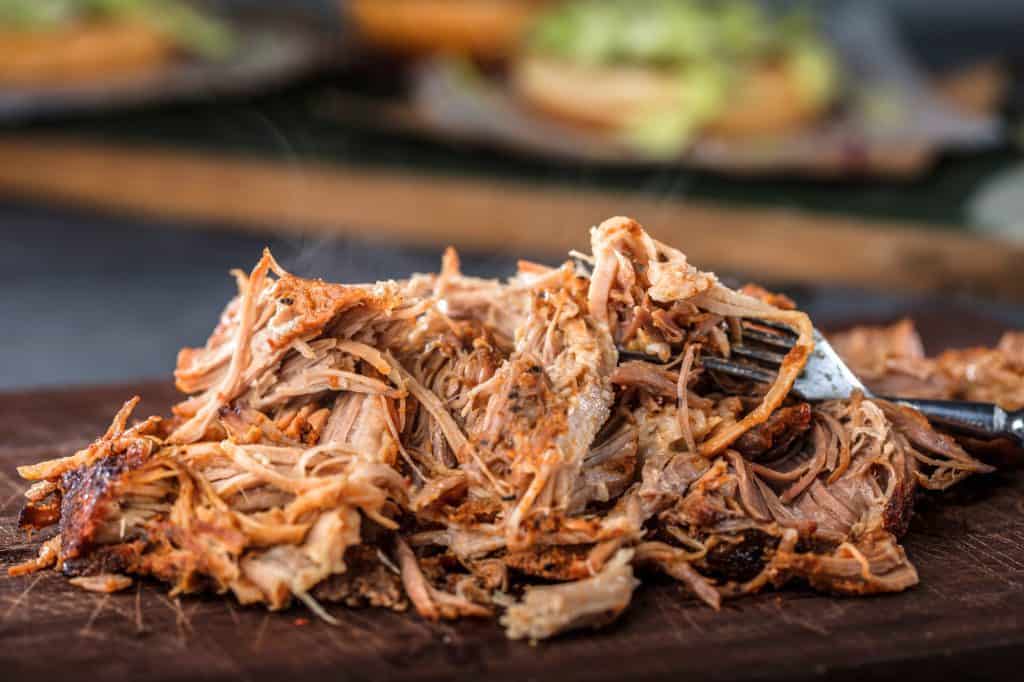One of the most heartbreaking moments after a lengthy cooking process is finding out your pulled pork is just a little tougher than you had expected.
Luckily even if your pulled pork IS tough, there are still a few things you can do to turn it more tender — even after you’ve taken it off the heat!
Here’s the reasons your pulled pork is so tough, what you can do to fix it, and what to do next time to get it so tender you can pull it apart with spoons!
A Quick Word On Pulled Pork

Not all cuts of pork can be turned into the stunning creation of pulled pork. It comes down to three main factors in the meat which when cooked at low temperatures for extended periods of time creates one of the most delicious meats known to man:
- The fat content and fat distribution, known as marbling.
- The size, length, and structure of the muscle fibers.
- The amount of connective tissue, including collagen, that connects the fibers together.
The fat melts over time, enhancing the savory flavor and providing moisture to the meat. The connective tissue effectively breaks down into gelatin and turns something very tough into something very tender. The muscle fibers absorb the flavor and moisture and become excessively tender which can be pulled apart into strands.
Once the masterpiece is complete, you can mix in additional flavors such as apple juice, barbecue sauce, rubs, or something spicy like chili powder or chili sauce. It’s really up to you and your flavor preference!
Why Is My Pulled Pork So Tough
One misconception is to blame the quality of the meat. But, you can make tender pulled pork whether you’ve got the highest-grade pork shoulder or a humble pork shoulder from Costco!
Instead, tough pulled pork is most commonly caused by either not cooking it long enough or simply by undercooking it. Although pork is safe to eat at temperatures above 145°F, realistically you need to bring it to an internal temperature of between 200-205°F to allow for all the connective tissue to break down and fat to effectively melt into the meat.
As well as cooking it to a high enough internal temperature, you also need to cook it long enough at these temperatures. This ensures all the connective tissue and fat has broken down and made the pork soft and tender.
If you cook the pork at high heat over a shorter amount of time, even if it reaches temperatures up to 205°F internally, there’s a good chance it’s still going to be tough as all the connective tissue will still be intact and hold the muscle fibers together. It’s imperative you cook the pork low and slow, otherwise, you will be left with tough pulled pork.
This is true no matter how you are cooking your pork, whether it’s in a slow cooker, crock pot, instant pot, or cooking it in a smoker!
Choosing The Right Cut Of Pork For Pulled Pork

It’s no surprise that some cuts of pork are fatty and some are lean. It all depends on how the muscles are used on the pig.
Generally speaking, the cuts of pork that are much leaner have much thinner muscle fibers. These are areas that get the least exercise on the pig, such as the tenderloin. Cuts like a pork chop or pork tenderloin work best when cooked hot and fast.
When it comes to pulled pork, you need a cut of pork that is rich in fat, connective tissue and has thicker muscle fibers. This is the perfect recipe for low and slow cooking as the fat melts, the connective tissue turns into soft gelatin, and the muscle fibers become tender and absorb all the savory juices.
The best cuts of pork for pulled pork are from the pork shoulder, which can be broken down into two main cuts. The front cut of the shoulder, the pork butt/Boston butt is often revered as the best cut for pulled pork due to its incredible fat content and marbling throughout. However, the back half of the pork shoulder is almost equally delectable, and both make for some prime-time pulled pork.
Other cuts you can use are a blade roast, cuts from the top of the leg to the shank, and even pork neck — all of which have a high fat content and can be cooked low and slow for some amazing pulled pork. If you’re cooking pulled pork for a crowd, be sure to use the same cut of pork to keep it all consistent.
Why Is My Pork Not Pulling?
If your pork isn’t pulling at all then it’s likely it’s far too underdone. Surprisingly this happens to most beginners — so don’t fret! Although pork is safe to eat from about 145°F, for pork to be able to pull it needs to reach much higher internal temperatures of at least 195°F. It also needs to cook for a decent length of time at these temperatures so that the fat melts and the connective tissue breaks down.
When the connective tissue breaks down it turns to a gelatin-like texture, which allows you to very easily pull apart the muscle fibers of the pork!
How To Fix Tough Pulled Pork
Whether you’ve already started pulling the pork, or it’s still on the cooker, there are a few things you can do at any stage to turn a tough pulled pork more tender.
Cook It Longer
If you’ve taken the pork off the heat and you’ve found out it’s still a bit tough, returning it to your cooker is always an option. The good thing about cooking large cuts of pork like pork shoulder, neck, or leg is that they are really hard to overcook. So long as you are going low and slow they will hardly ever become dry, and cooking them to internal temperatures up to 205°F will reward you with ridiculously tender meat.
Even if you’ve already pulled the pork you can still cook it longer!
Simply put all your pulled pork into an oven-safe dish or aluminum tray, add a cup of apple juice and a cup of your favorite BBQ sauce and mix thoroughly. Cover your tray with a layer of aluminum foil and place it into a preheated oven at 225-250°F.
The foil will prevent any escape of juices through evaporation and the heat will continue to break down the connective tissue and fat surrounding your pulled pork. After an hour or two, you will be rewarded with much more tender pulled pork, with the added flavor from the juice and sauce!
This process can be repeated when you’re reheating your leftover pulled pork too!
Rest It Longer
I know how tempting it is to pull the pork straight after it’s come off the smoker or out of the oven. But resting large cuts of pork is a vital part of the cooking process. Not only will the pork’s internal temperature rise about 5°F and continue cooking over the entire resting process, but it will also help the meat reabsorb and redistribute all the juices.
If your pork still feels tough and you’ve got time on your hands, there is no harm in continuing the resting process for as long as the meat stays at food-safe temperatures above 140°F.
How To Prevent Tough Pulled Pork Next Time
Because there is no immediate fix for a tough pulled pork, the best way to fix it is just to prevent it from happening next time. Thankfully it’s not rocket science. It usually just comes down to cooking it longer and at a lower heat, but there are a few good tips to always get a nice tender pulled pork.
Cook To Tenderness
Instead of cooking for a specific time and to a specific internal temperature, the best way to avoid tough pulled pork is to always cook to desired tenderness.
This really is the failsafe method, as with large fatty cuts like pork butt or pork shoulder it is quite hard to overcook them. Use internal temperature as a baseline, knowing that you’ll need to hit at least about 200°F for all the connective tissue to have broken down. But, if it’s still tough at 200°F then keep the heat rolling until it probes like butter and you’re happy with the tenderness.
This doesn’t change whether you’re using an oven or smoker or if it’s thawed pork shoulder or even frozen pork shoulder.
Cook It On A Lower Heat (And For Longer)
If you’re still finding your pork is coming out tough, then you might want to try going at an even lower temperature for a lot longer.
I’m not a patient man but I know the value in keeping the temperature low and slow. Although you can cook at temperatures up to 250°F-275°F and still get amazingly tender pulled pork, 225°F tends to be the sweet spot, particularly when you’re smoking it.
By cooking it lower and it will naturally cook at the vital internal temperatures a lot longer, allowing much more time to break down the fat and connective tissue at every stage of the cook. if you’re preparing a smoked pork shoulder check out the best woods to use for pork shoulder.


